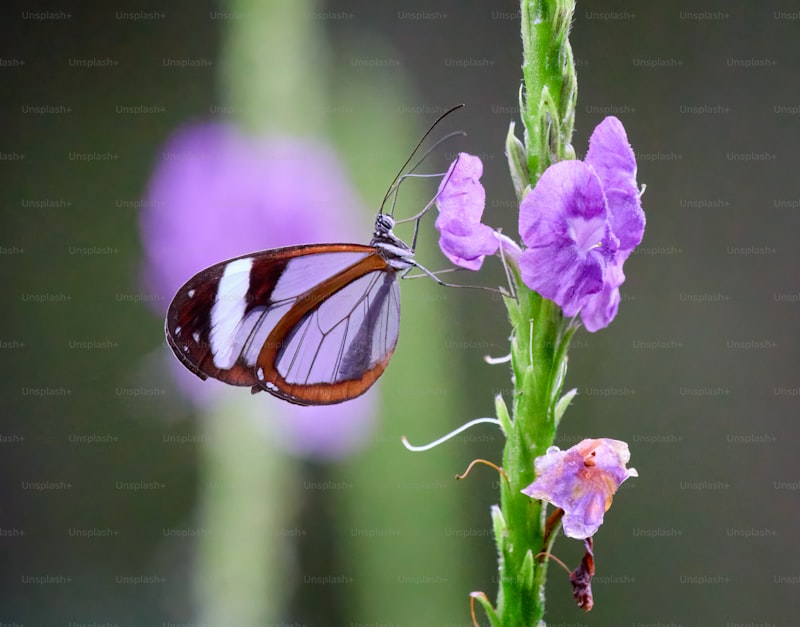Welcome to the vibrant world of butterfly gardening! Creating a butterfly garden is not just about planting flowers; it’s about crafting a haven that attracts and nurtures these delicate creatures. Imagine your garden as a canvas where each plant is a brushstroke, painting a picture that butterflies find irresistible.
To start your butterfly garden, choose plants that serve as nectar sources. Butterflies are particularly fond of bright, fragrant flowers like lavender, milkweed, and butterfly bush. These plants not only provide sustenance but also add color and fragrance to your outdoor space.
Next, consider adding host plants. These are essential for butterflies to lay their eggs and for caterpillars to feed on once they hatch. Examples include milkweed for monarch butterflies and parsley for swallowtails. Hosting these plants ensures the full life cycle of butterflies can unfold right before your eyes.
When planning your garden layout, think diversity. Butterflies are attracted to a variety of flowers and environments. Mix annuals and perennials to provide continuous blooms throughout the seasons. Incorporate plants of different heights and textures to create layers and niches for butterflies to explore and rest.
Butterflies, like us, appreciate a welcoming environment. Ensure your garden has sunny spots for butterflies to bask in the warmth and sheltered areas where they can seek refuge from wind and predators. A small water source, such as a shallow dish with wet sand or rocks, can also provide hydration and a place for butterflies to puddle.

As you tend to your butterfly garden, observe and learn. Notice which butterflies visit your garden and when. Take note of their behavior and preferences. By understanding their habits, you can continuously improve your garden to better suit their needs.
Creating a butterfly garden is more than just gardening; it’s fostering a habitat where nature thrives and beauty unfolds. It’s about creating a space where every flutter of wings brings joy and wonderment, where you become part of the delicate dance of nature.
Transform Your Garden: A Beginner’s Guide to Butterfly Gardening
Have you ever dreamed of turning your garden into a vibrant sanctuary buzzing with the gentle flutter of butterflies? Butterfly gardening is not just about planting flowers; it’s about creating a welcoming habitat that attracts these beautiful creatures. Whether you’re a novice gardener or looking to revamp your outdoor space, here’s your ultimate guide to starting a butterfly garden from scratch.
First things first, location matters. Butterflies thrive in sunny spots sheltered from strong winds. Choose an area in your garden that receives at least six hours of sunlight daily. This ensures your butterfly-attracting plants get the warmth they need to bloom and lure in these delicate visitors.
Next, select the right plants. Butterflies are particularly drawn to nectar-rich flowers such as butterfly bush (Buddleja), milkweed (Asclepias), and lavender (Lavandula). These plants not only provide sustenance but also serve as landing pads for butterflies to rest and bask in the sun. Remember to plant a variety of flowers that bloom at different times of the year to ensure a continuous food supply.
Creating a diverse ecosystem is key to a successful butterfly garden. Integrate host plants like milkweed, which caterpillars feed on exclusively. This encourages butterflies to lay eggs, completing their life cycle in your garden. Embrace native plants as they are well-adapted to your region’s climate and soil, requiring less maintenance while supporting local butterfly species.
Consider adding features that attract butterflies beyond plants. A shallow dish filled with damp sand or soil provides essential minerals and salts, crucial for butterfly nutrition. Additionally, rocks and logs offer resting spots and shelter from predators, making your garden a safe haven for these delicate insects.
Maintaining a butterfly garden involves regular care and observation. Keep your garden pesticide-free as butterflies are highly sensitive to chemicals. Instead, opt for natural pest control methods and encourage beneficial insects like ladybugs and lacewings to thrive alongside butterflies.
Now that you have the basics, it’s time to embark on your butterfly gardening journey. With patience and a passion for nature, transform your garden into a haven where butterflies dance amidst a tapestry of blooming flowers. Welcome these winged wonders into your space and witness the magic of nature unfold before your eyes.
Step-by-Step: Creating a Butterfly Sanctuary in Your Backyard
Ever wondered how you can transform your backyard into a vibrant haven for butterflies? Imagine stepping outside to be greeted by fluttering wings and bursts of color dancing among your flowers. Creating a butterfly sanctuary is not only rewarding but also surprisingly easy. Let’s dive into the steps you can take to bring these beautiful creatures closer to home.
-
Choose the Right Plants: Butterflies are attracted to specific plants that provide nectar and serve as host plants for their larvae. Opt for a variety of native plants such as milkweed, coneflowers, and butterfly bush. These plants not only nourish adult butterflies but also support caterpillars during their early stages.
-
Create a Sunlit Spot: Butterflies are cold-blooded creatures and thrive in sunny spots. Choose an area in your garden that receives ample sunlight throughout the day. This warmth helps butterflies regulate their body temperature and stay active.
-
Provide Shelter and Water: Butterflies seek shelter from wind and rain. Consider planting shrubs or adding a small butterfly house where they can rest safely. Additionally, provide a shallow dish with damp sand or mud for butterflies to sip water and extract essential minerals.
-
Avoid Pesticides: To maintain a healthy butterfly population, minimize the use of pesticides in your garden. These chemicals can harm butterflies directly or indirectly by eliminating their food sources.
-
Add Color and Texture: Butterflies are attracted to bright colors, especially shades of red, orange, yellow, and purple. Plant flowers in clusters to create visual appeal and provide landing pads for butterflies to feed.
-
Maintain Your Garden: Regular maintenance ensures your butterfly sanctuary remains inviting. Remove weeds that compete with host plants and deadhead flowers to encourage continuous blooming.
-
Observe and Enjoy: Once your butterfly sanctuary is established, take time to observe these winged visitors. Identify different species and learn about their behaviors. With patience and care, your garden will become a thriving ecosystem for butterflies to flourish.
Unlock the Secrets of Butterfly Habitats with This Comprehensive Gardening Guide
Butterflies are not just beautiful; they are indicators of a healthy ecosystem. To invite them into your garden, start by selecting plants that serve as host species for butterfly larvae. Milkweed, for instance, is essential for monarch butterflies. Incorporating a variety of nectar-rich flowers such as lavender, coneflowers, and butterfly bush ensures a continuous food source for adult butterflies.
Sunlight is crucial for butterflies. Design your garden to receive ample sunlight throughout the day, as butterflies are cold-blooded and require warmth to function optimally. Providing shelter from strong winds and predators through shrubs and small trees also helps create a safe haven.
Water is another essential element. Butterflies need moisture not only to drink but also to regulate their body temperature. Consider incorporating shallow dishes filled with damp sand or pebbles for puddling, which provides essential minerals.
Avoid pesticide use in your butterfly garden, as these chemicals can harm both butterflies and their larvae. Opt for natural pest control methods and encourage beneficial insects like ladybugs and lacewings to thrive alongside butterflies.
Observing butterflies in your garden is a joyous experience that deepens your connection to nature. By nurturing a habitat that meets their needs throughout their life cycle, you contribute to the conservation of these graceful creatures while creating a serene oasis in your own backyard.
From Caterpillar to Butterfly: Cultivating Your Garden for Complete Metamorphosis
Start by choosing plants that caterpillars love to feast on, such as milkweed, parsley, and dill. These plants not only provide essential nutrients but also attract butterflies to lay their eggs. As caterpillars hatch and begin munching on leaves, you’ll witness the first phase of metamorphosis up close.
Next, create diverse habitats within your garden. Butterflies need sheltered spots to rest and hide from predators, so include shrubs, tall grasses, and even small rocks where they can perch. These areas also serve as ideal locations for caterpillars to form their chrysalides when they’re ready to pupate.
Ensure your garden is a safe haven by avoiding pesticides. Opt for organic pest control methods or companion planting to deter pests without harming beneficial insects like butterflies. Remember, a healthy garden ecosystem supports all stages of butterfly life, from egg to adult.
Encourage biodiversity by planting a variety of flowers that bloom throughout the seasons. Butterflies rely on nectar as their primary food source, so having a continuous supply ensures they stay nourished. Choose native flowers like coneflowers, butterfly bush, and bee balm to attract a wide range of butterfly species.
Lastly, embrace patience and observation. The transformation from caterpillar to butterfly is a natural wonder that unfolds over time. By nurturing your garden with care and providing for every stage of the butterfly’s life cycle, you create a sanctuary where magic happens—a place where caterpillars thrive and emerge as graceful butterflies, enriching both your garden and your soul.
Attracting Winged Wonders: Essential Plants and Flowers for Butterfly Gardens
Butterflies are attracted to nectar-rich blooms that offer both sustenance and shelter. Flowers like lavender, with its fragrant spikes of purple, act as a magnet, drawing butterflies with their sweet aroma and abundant nectar. Their sturdy stems also provide a perfect perch for these winged visitors.
Another favorite is the vibrant coneflower, standing tall with its daisy-like petals in shades of pink, purple, and white. These hardy blooms not only add a burst of color but also serve as a vital food source, hosting butterflies like the Monarch and Swallowtail throughout the seasons.

Milkweed, often associated with the Monarch butterfly, is essential. Its clusters of tiny, star-shaped flowers produce a rich nectar that sustains these iconic butterflies during their migrations. Planting milkweed ensures a steady supply of food for caterpillars and butterflies alike, supporting their life cycle from egg to adult.
For a touch of elegance, consider the butterfly bush, aptly named for its ability to attract butterflies from afar. Its long, cone-shaped clusters of flowers, available in hues from lavender to deep purple, emit a scent that beckons butterflies like a beacon in the garden.
Lastly, don’t overlook the humble marigold. Its bright, cheerful blooms not only repel pests but also attract butterflies with their sunny colors and inviting fragrance. Marigolds thrive in various climates and soil types, making them a versatile addition to any butterfly garden.
By carefully selecting these plants and flowers, you can transform your outdoor space into a sanctuary for butterflies, where every fluttering visitor adds to the enchantment of your garden.
Beyond Flowers: Essential Tips for Creating a Butterfly-Friendly Landscape
To start, consider the essential elements that attract butterflies. They are drawn to nectar-rich flowers like milkweed, butterfly bush, and coneflowers. These plants not only provide sustenance but also act as landing pads and shelter. Think of your garden as a buffet for butterflies, offering a diverse menu of nectar sources throughout the seasons.
Next, ensure there are sunny spots in your landscape. Butterflies are cold-blooded creatures that rely on the warmth of the sun to regulate their body temperature. Design your garden with open areas where butterflies can bask in the sun, spreading their wings to absorb its gentle warmth.
Incorporate host plants into your garden layout. These are specific plants where butterflies lay their eggs, providing essential food for caterpillars. For instance, milkweed is crucial for monarch butterflies, while parsley and dill attract swallowtails. By including host plants, you encourage the complete life cycle of butterflies, from egg to caterpillar to adult.
Avoid using pesticides in your butterfly garden. These chemicals can harm butterflies and their larvae. Instead, opt for natural pest control methods or companion planting to deter unwanted insects without compromising the butterfly habitat.
Add elements of water to your landscape. Butterflies, like many creatures, need water to drink. A shallow dish filled with water and pebbles provides a safe drinking spot for butterflies while also serving as a beautiful garden feature.
Lastly, create varied heights and textures in your garden. Butterflies navigate by sight and are attracted to patches that offer different heights of plants and a variety of textures. Mix tall flowers with ground covers and ornamental grasses to create a visually appealing and butterfly-friendly environment.
By incorporating these tips into your garden design, you transform your outdoor space into a haven for butterflies, where they can feed, rest, and complete their life cycle. Watch as your garden becomes a vibrant sanctuary, buzzing with the gentle flutter of butterfly wings, adding magic and wonder to your surroundings.
Frequently Asked Questions
How do I create a butterfly-friendly habitat?
Learn how to create a butterfly-friendly habitat with our concise guide. Discover essential steps and tips to attract butterflies to your garden or outdoor space. Create an environment that supports their lifecycle and provides necessary resources like food and shelter.
What seasonal considerations should I keep in mind for butterfly gardening?
Discover essential seasonal tips for successful butterfly gardening. Learn how to plan your garden to attract butterflies year-round with expert advice on planting schedules and seasonal plant choices.
How can I prevent pests while attracting butterflies?
Learn effective methods to attract butterflies while preventing pests in your garden. Discover natural deterrents and planting strategies for a harmonious butterfly-friendly environment.
What are the best butterfly species for beginners?
Discover the ideal butterfly species for beginners with our concise guide. Learn about easy-to-care-for varieties that are perfect for starting your butterfly garden or habitat.
What plants attract butterflies to my garden?
Learn about the plants that attract butterflies to your garden with our concise guide. Discover which flowers and herbs are irresistible to butterflies, creating a vibrant and colorful environment in your outdoor space. Enhance your garden’s appeal and support local butterfly populations with the right plant choices.


